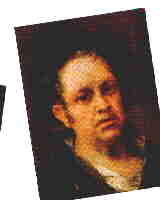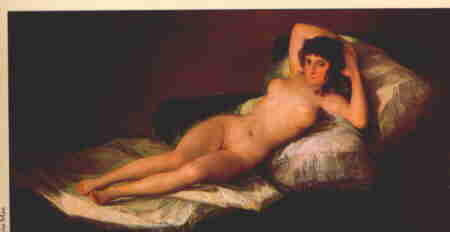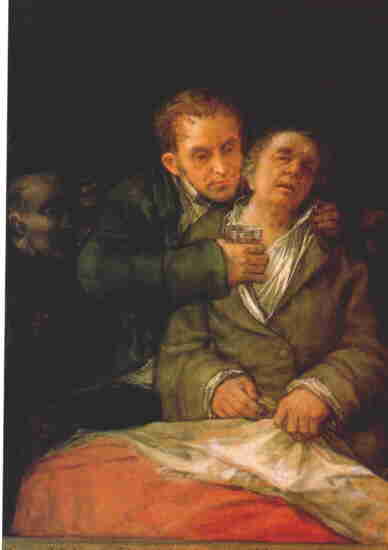 PART OF THE ARTSCHOOL
ONLINE NETWORK
PART OF THE ARTSCHOOL
ONLINE NETWORK
 THE
LIFE AND TIMES OF FRANCISCO DE GOYA
THE
LIFE AND TIMES OF FRANCISCO DE GOYA
Francisco de Goya y Lucientes, the son of a gilder, was
born on 30 March 1746 in the desolate village of Fuendetodos in western
Spain. When he was 14, the family moved to Saragossa, the capital of his
native region of Aragon, and Francisco was apprenticed to the painter Jose
Luzan - at that time the leading artist of Saragossa. (One of his specialties
was adding drapery to nude figures in religious pictures, for which he
was given the official title of "Reviser of Indecent Paintings".) In Saragossa,
Goya also met the painter Francisco Bayeu, who was 12 years older than
him and enjoying the rapidly growing success that in 1763 led him to the
court of Madrid. Goya moved to Madrid soon after Bayeu and worked in his
studio.
MADRID, CENTER OF THE ARTS
To be established at Madrid was, at this time, virtually
the only way in which a provincial Spanish artist could gain more than
mere local recognition. The great wealth of the Spanish monarchy and its
lavish patronage of the arts also attracted some of the major painters
from elsewhere in Europe. In the 1760s and 1770s the two most important
painters at the court were the Venetian Giambattista Tiepolo and the German
Anton Raffael Mengs, both of whom had a major influence on Goya's evolution
as an artist.
In 1763 and 1766 Goya made unsuccessful attempts to enter
the recently founded Madrid Academy of Art and then, probably in 1770,
he did what was customary for ambitious young artists: he went to Italy.
Here he enjoyed his first minor success, getting an honorable mention in
a painting competition organized by the Art Academy of Parma. In 1771 he
returned to Spain, and two years later married Bayeu's sister, Josefa.
The following year he was summoned to work, first under Mengs and then
Bayeu, on cartoons for tapestries to be woven at the Royal Factory of Santa
Barbara in Madrid. This task was to occupy him sporadically until 1792.
Goya's beginnings as an artist were slow and unremarkable.
It was not until the 1780s, when he was already in his mid-30s, that important
official recognition came his way. In 1780 he was elected a member of the
Madrid Academy and five years later he was made Deputy Director of Painting
there. After Charles VI was crowned in 1789, Goya achieved his ambition
of becoming one of the royal painters, a promotion which he celebrated
by adding the aristocratic 'de' to his name.
In the 1790s, with the tapestry designs completed, Goya
devoted himself principally to the types of work by which he is best known
today - portraits and imaginative compositions. Towards the end of 1792
a traumatic change occurred in his life when he developed a mysterious
illness - variously and unconvincingly interpreted as syphilis, lead poisoning
from the use of white paint, and even a particularly severe nervous breakdown.
At any rate, it caused him temporary paralysis and partial blindness, and
left him permanently deaf. The illness had a significant effect on the
development of Goya's art. While convalescing in 1793 he painted a series
of small oil paintings of bizarre subjects of "fantasy and invention",
as Goya himself described them, telling the Academy later that he had produced
them "In order to occupy an imagination mortified by the contemplation
of my sufferings".
Goy's increasingly introverted and morbidly imaginative
tendencies as an artist were not greatly appreciated by his contemporaries.
But they did not in any way impede his rising eminence in the Madrid art
world. In 1795, on the death of Bayeu, he was promoted to Director of Painting
at the Academy, and in 1798 received the prestigious commission to decorate
the Madrid church of S. Antonio de la Florida. The following year he was
appointed First Painter to the King. By now he could count among his friends
and patrons many leading intellectuals and aristrocrats in Madrid.
THE NAKED MAJA
 Goya
was on particularly close terms with the widowed Duchess of Alba - a beautiful,
intelligent and powerful woman. Their relationship was the source of much
gossip, especially after Goya spent the summer of 1796 on her estate in
Andalusia, where the Duchess had moved after the death of her husband.
One of the most popular legends in the history of art holds that she was
the model for Goya's famous pair of paintings, The Naked Maja (LEFT)
and The Clothed Maja.
Goya
was on particularly close terms with the widowed Duchess of Alba - a beautiful,
intelligent and powerful woman. Their relationship was the source of much
gossip, especially after Goya spent the summer of 1796 on her estate in
Andalusia, where the Duchess had moved after the death of her husband.
One of the most popular legends in the history of art holds that she was
the model for Goya's famous pair of paintings, The Naked Maja (LEFT)
and The Clothed Maja.
Such speculation has often been used to flesh out the
rather meager information we have concerning the less public aspects of
Goya's personality. He has been depicted variously as a relentless womanizer,
a manic depressive, a revolutionary, and a sort of Hamlet-like figure viewing
society with growing skepticism and pessimism and ultimately achieving
an almost other-worldly detachment from it. However, the evidence for all
this is scanty. The known facts of Goya's life reveal little more than
a great concern with his social standing, financial shrewdness, a love
of pigeon-shooting, and an unwillingness to allow political and other forms
of idealism to get in the way of the practical considerations of living.
The first half of Goya's life was a time of political
stability in Spain. But the reign of Charles IV (1789 - 1808) saw mounting
unrest, made even worse by the international repercussions of the French
Revolution. Charles was a weak and lazy ruler, greatly influenced by his
strong-minded wife, Maria Luisa, who in turn was led by the upstart favorite,
Manuel de Godoy. The rule of this "trinity on earth", as the queen described
it, was highly unpopular with both nobility and public alike. Eventually,
in 1808, mass disturbances caused the downfall of Godoy and forced Charles
IV to resign in favor of his son Ferdinand VII.
Ferdinand, in league with the French, at first welcomed
Napoleon's armies into Spain. But almost immediately he was forced to hand
over his throne to Napoleon's brother, Joseph. The French occupation provoked
serious rioting in Madrid and led to bloody civil war. Goya's own allegiances
are not clear, but he was appalled by the brutality of the fighting, and
in his horrific series of etchings, the Disasters of War, he portrayed
atrocities committed by both sides.
HONORED BY THE ENEMY
Whatever Goya's political views, he also had to make a living,
and it was therefore prudent of him, if not especially principled, to swear
allegiance to the French king and accept from him in 1811 the Royal Order
of Spain. This caused him trouble later when Ferdinand VII was restored
to the throne in 1814, following the intervention of British troops under
the Duke of Wellington (whom Goya was also quite happy to portray). But
Goya escaped the punishment meted out to some of his liberal friends by
claiming that he had never worn the medal awarded to him by the French.
In addition he offered to paint for the king his two famous scenes of the
Madrid rioting that had led to the war: The Second of May, 1808
and The third of May, 1808
The gloom of Goya's later painting reflects the morbidly
repressive atmosphere in Spain following the restoration of Ferdinand VII.
Universities and theaters were closed down, press censorship was introduced,
and the dreadful religious tribunal, the Inquisition, was re-established.
No sooner had Goya been exonerated from the charge of having accepted employment
from the usurper than he found himself summoned in front of the Inquisition
to explain why and for whom he had painted the allegedly obscene Naked
Maja and its companion piece. The artist had other problems to contend
with. His wife had died in 1812, and he was now embarked on an affair with
a married woman, Leocadia Weiss, which put him at the center of malicious
gossip.
WITHDRAWL FROM PUBLIC LIFE
 Ferdinand
VII took hardly any interest in Goya, but kept him on as his First Painter.
And when Goya eventually retired from the post, Ferdinand awarded him a
generous pension, which enabled him to live comfortably until his death.
He virtually withdrew from public life after 1815, and worked almost exclusively
for himself and for his close circle of friends.
Ferdinand
VII took hardly any interest in Goya, but kept him on as his First Painter.
And when Goya eventually retired from the post, Ferdinand awarded him a
generous pension, which enabled him to live comfortably until his death.
He virtually withdrew from public life after 1815, and worked almost exclusively
for himself and for his close circle of friends.
In 1819, serious illness struck Goya again, and he recovered
only thanks to the intervention of the fashionable Madrid doctor, Eugenio
Garcia Arrieta. In gratitude, Goya painted an extraordinary double portrait,
showing himself half-dying in bed being supported by Arrieta, who is offering
him a draught of medicine; in the background is a group of dark and sinister
figures. (left)
Similar reflections on death and old age are to be found
in the "black paintings" that he executed between 1820 and 1823 on the
walls of his newly acquired house (the "Quinta del Sordo' or "House of
the Deaf Man") in the country outside Madrid.
The three years during which the artist was engaged on
these works, perhaps the most terrifying and technically astonishing in
his career, saw a brief moment of liberalization in Ferdinand's regime.
However, by the end of 1823, reaction had set in again, and many of Goya's
liberal friends sought refuge in France. A number of them went to Bordeaux,
including Leocadia Weiss, who took the two children she had supposedly
had by Goya. He joined her there soon afterwards, having been granted temporary
leave of absence by the king on the pretext that he needed to take the
waters at Plombieres for his health.
Goya was found by his friends now to be deaf, old, slow
and feeble. But his enthusiasm for life was apparently as strong as ever,
and his artistic powers were undimmed. He still had enough strength to
make an extended sight-seeing trip to Paris, and even began experimenting
with the new medium of lithography in his series the Bulls of Bordeaux.
To the surprise of his fellow exiles, he made two brief return trips to
Spain, on the first of which (in 1826) he officially handed in his resignation
as court painter.
In the spring of 1828, he was visited in Bordeaux by
his daughter-in-law and grandchildren. The excitement caused by there visit
made him, in his own words, a "little indisposed". He died on 16 April
following a paralytic stroke, aged 82. His mortal remains were returned
to Spain in 1900 and interred in the cemetery of San Isidro in Madrid.
 THE THIRD OF MAY, 1808 (above)
Perhaps the most known of all of Goya's works.
GALLERY OF GOYA PAINTINGS
THE THIRD OF MAY, 1808 (above)
Perhaps the most known of all of Goya's works.
GALLERY OF GOYA PAINTINGS
BACK TO MAIN PAGE
 THE
LIFE AND TIMES OF FRANCISCO DE GOYA
THE
LIFE AND TIMES OF FRANCISCO DE GOYA
 Goya
was on particularly close terms with the widowed Duchess of Alba - a beautiful,
intelligent and powerful woman. Their relationship was the source of much
gossip, especially after Goya spent the summer of 1796 on her estate in
Andalusia, where the Duchess had moved after the death of her husband.
One of the most popular legends in the history of art holds that she was
the model for Goya's famous pair of paintings, The Naked Maja (LEFT)
and The Clothed Maja.
Goya
was on particularly close terms with the widowed Duchess of Alba - a beautiful,
intelligent and powerful woman. Their relationship was the source of much
gossip, especially after Goya spent the summer of 1796 on her estate in
Andalusia, where the Duchess had moved after the death of her husband.
One of the most popular legends in the history of art holds that she was
the model for Goya's famous pair of paintings, The Naked Maja (LEFT)
and The Clothed Maja.
 Ferdinand
VII took hardly any interest in Goya, but kept him on as his First Painter.
And when Goya eventually retired from the post, Ferdinand awarded him a
generous pension, which enabled him to live comfortably until his death.
He virtually withdrew from public life after 1815, and worked almost exclusively
for himself and for his close circle of friends.
Ferdinand
VII took hardly any interest in Goya, but kept him on as his First Painter.
And when Goya eventually retired from the post, Ferdinand awarded him a
generous pension, which enabled him to live comfortably until his death.
He virtually withdrew from public life after 1815, and worked almost exclusively
for himself and for his close circle of friends.
